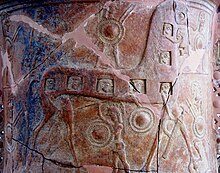Mykonos vase
Appearance

The Mykonos vase, a pithos, is the earliest dated object (Archaic period, ca. 670 BC) which depicts the Trojan Horse during the Trojan War. It was found in 1961 on Mykonos in Greece, for which it is named, by a local islander.[1]
References
- ^ Paipetis, S. A (2010). The Unknown Technology in Homer. Springer Science & Business Media. p. 171. ISBN 978-90-481-2514-2.
Bibliography
- Michael John Anderson, The Fall of Troy in Early Greek Poetry and Art, 1997.
- Miriam Ervin Caskey, "Notes on Relief Pithoi of the Tenian-Boiotian Group", AJA, 80, 1976, pp. 19–41.
- M. Ervin, "A Relief Pithos from Mykonos", Deltion, 18, 1963, 37-75.
- J.M. Hurwit, The Art and Culture of Early Greece, 1100-480 B.C, 1985
- M. Wood, In Search of the Trojan War, 1985.
- http://www.uwm.edu/Course/mythology/1200/twar2.htm
